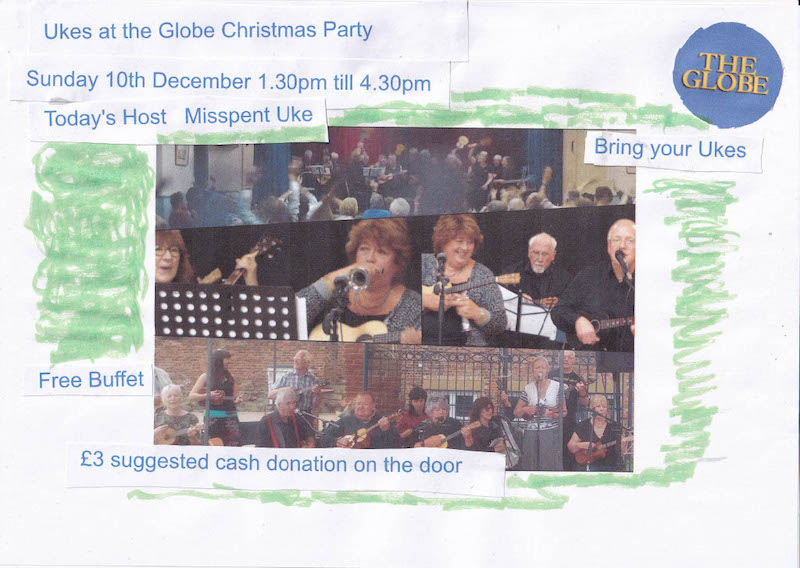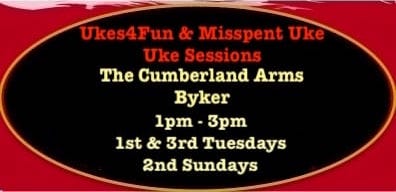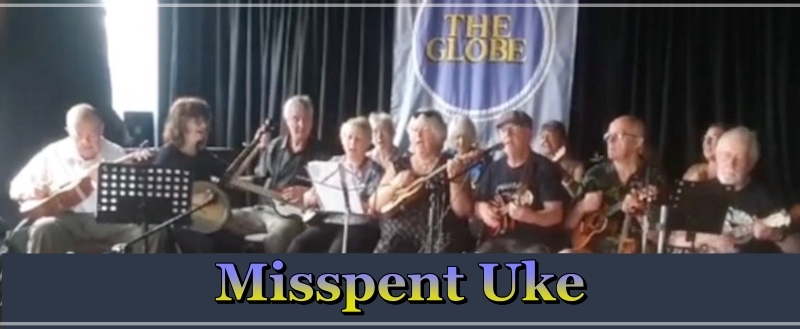Some “off the top of my head” thoughts on this, prompted by discussions with Jim Carey, of “Jim’s Songbooks” at ozbcoz.com, and Songsheet Generator developer Christian.
I am extrapolating from reflections on my personal experience here and yours might be different. Please feel free to comment on how “your mileage differs”, or to dispute or confirm statements I have made about reading, the effect of different fonts, etc.
- Please try to resist commenting to the effect that Song Sheets are in themselves a “bad thing”. They have their place – let’s leave it at that. You will be wasting your time anyway – comments are moderated and I will simply delete any that seek to hijack this topic. You have been warned!
Chord names above the line vs in-line and novelty vs familiarity
I have noticed that my preference for above the line or in-line chords depends on my familiarity with the chords in a song, ie. more than familiarity with a particular song.
When I started off playing ukulele, I found in-line chord names slowed me up
- I was unfamiliar with the names
- I did not know what I might see
- it was hard to “isolate” them from the surrounding text as distinct units.
When I became more familiar with “common chord names” I started to find it more efficient to use song sheets with in-line “common chord names”.
I imagine that this might be something to do with the way our eyes scan very quickly forwards and backwards (saccadic eye movement) when we are reading, enabling us to build up expectations and predictions of “what comes next”.
Now, when I am learning to play a song with less familiar chord names, even a song that I have written myself, I still want the chord names above the line at first, so that they stand out better.
Gradually, I get a “sight vocabulary” for the new chord names:
- they become easier to recognise
- I also know how they “translate” into playing chords
- and moving from one chord to another.
Eventually, it becomes a reflex reaction, with the chord name being linked to muscle memory, whether I am told the name of the chord or read it.
At that point, I do not need to have the chord names written above the line in order to isolate and recognise them. It works better to have them in-line so that my visual scanning is not interrupted.
Chord grids above the line
A bit off topic but so closely related that they are worth a mention.
I have always found this type of songsheet impossibly distracting to use – unless I already know how to play the chords. Then, I force myself to “block out” the chord grids so that I am paying no attention to them. I have found that this gets easier with practice; as long as there are not too many chord changes, and the sheet is peppered with grids!
Being the ultimate in distraction, and therefore inevitably putting a foot on the brake, I have a sneaking suspicion that I will come to value song sheets with chord grids above the line at some point. That point when I decide that I want to learn how to play one of those jazzy songs with a death-defying chord change almost every syllable or beat!
Tab and musical scores
Not what this post is about but not completely unrelated. Maybe I should have tried to find research into reading tab and scores? It is more likely to have been done, especially for musical scores, and it might have some bearing.
I will leave it at that and hope that someone might happen by to comment to expand on this.
Accurate Reading vs Scanning, a Font Analogy?
I have not really thought much about this phenomenon before, ie. the difference between reading song sheets with chords above the line vs in-line. I have noticed it but not tried to analyse or understand it. Now that I have thought about it, it makes me wonder if it analogous to the way that different fonts are useful for different types of reading.
“Ugly” fonts for accuracy and learning
“Ugly” fonts like Courier and “fancy fonts” with serifs and obvious descender and risers slow down reading. They are good when there needs to be attention to detail and accuracy, eg. writing computer programs. There is some evidence that they also help children who are behind with their reading skills to “catch up”.
- These would be analogous to chord names above the line, as normal visual scanning with automatic saccadic eye movement is hindered. We are interrupted as the chord names above the line come to our attention and we focus on them.
“Smooth” fonts for fast reading of familiar vocabulary and predictable content
Smooth, regular fonts, often with poor differentiation between different characters, eg. Arial, are good for “speed reading” where we only need to get the gist and accuracy is not critical.
- These would be analogous to in-line chords, but only when we are so familiar with the chord names that visual shape of the name has become a “word” in our “chord vocabulary”: we recognise it and know what it means.
Are in-line chord names the better option for songs with familiar chords?
I think that this would depend on how we are going to play those chords. This would apply whether in first position or other voicings.
Assuming that we “know” (consciously or unconsciously) how we are going to play them and that we are fluent playing them, then we should not need to focus on the chord names individually in order to read and react to them:
- we would be using normal saccadic scanning
- our muscle memory would be kicking in before we were consciously aware of seeing the chord name as it comes up
If I am right in that, then the effect should be even more pronounced with people who know what chords to expect, based on:
- the Key of the song
- the genre of music
- the habits of a particular song writer
- their previous knowledge of that song, even in a different key
Caveats and Conclusion
There really should be references for some of the things I am have said here. However, I know that if I put this on the “back burner” until I have time to look them up then that is where it will stay. I did do a rather cursory search for any research directly related to this subject but did not turn anything up.
There are several other blog posts that have been lurking on the “back burner”, some or them for years, waiting for me to find the time to reference them. I don’t want to add this one to that backlog!
These are just my first thoughts on this topic. I really would be very interested in comments.
I should perhaps explain that my interest in reading and fonts is because I was Speech & Language Therapist for 30 years.
- As well as the “therapy” side of things, I had a serious interest in ensuring accessibility of communication in print and on-screen.
- At one time I had responsibility for auditing information leaflets, signage, etc. in the part of the NHS Trust where I worked.
- However, it is several years since I have worked as a Speech & Language Therapist and some of the points I have made here might have been overtsken by more recent reseach.









I’m glad you mentioned fonts here, because there’s a strong connection between choice of typeface (pedant alert – fonts are sizes, not typefaces 🙂 ) and the decision whether to use in-line or above the line songsheets.
If you’re going to use above the line songsheets, you really do have to use a monospaced type, such as Courier (or Andale Mono, or Consolas, or Monaco), otherwise you’ll never get the chords to line up correctly above the lyrics. For inline songsheets you can use whatever type you like, and there, proportional types such as Arial do have the advantage in terms of readability.
As to chord diagrams above the lyric, Doctor Uke’s songsheets are a great instance of where this style works.
LikeLike
Hi Paul!
Thank you for your reply! You are right of course about typeface vs font – I should know better!
Right about the monospaced type too, although it does depend how you create the song sheet. It would drive me bonkers doing it in a word processor and fiddling about getting the chord names in the correct place above the line.
So, to save my sanity, what I use is Songsheet Generator. It is one of those applications that reads a plain text file written in Chordpro format and renders it into a print-ready version with chord names above the line.
That also means that I do not have to stick to monospaced fonts (Drat! Did it again!). My preferred typeface is (ahem!) “Aphont”, free from the American Printing House for The Blind if you “qualify”:
There is a box to tick: “By checking this box you certify that APHont will be used for or by persons with a visual impairment.”
That covers just about every ukulele session I have attended! Even before I got cataracts of my own to peer through!
“APHont™: A Font for Low Vision
Free Font Download for Qualified Users
APHont™ (pronounced Ay’-font), was developed by APH specifically for low vision readers. APHont embodies characteristics that have been shown to enhance reading speed, comprehension, and comfort for large print users.
The entire APHont Suite is available free-of-charge to qualified users for non-commercial purposes. The APHont Suite consists of Regular, Bold, Italic, and Italic Bold. You must certify use for or by a person with a visual impairment before downloading.
Features
More even spacing between letters.
Higher crossbars.
No serifs.
Wider letters.
Heavier letters.
Underslung “j” and “q”.
Letters more open.
Larger punctuation marks.
https://www.aph.org/products/aphont/
Now, chord grids above the line . . . I steered clear of mentioning Doctor Uke. He does a WONDERFUL job with those song sheets – but they are exactly the ones that I find so distracting. I find it impossible to “screen out” those chord diagrams so that I can attend to the lyrics and the “flow” of the song.
I am sure that it would get easier with practice . . . and motivation!
. . . A friend of mine, a singer, took up the ukulele in around 2006 and by 2010 was playing with a semi-professional ukulele band, playing paid gigs twice a week and rehearsing once a week for about three years. They had a massive repertoire of songs from the 20’s up to the 50’s and almost always performed using song sheets with chord diagrams above the line, like the Doctor Uke ones. They were very entertaining and engaging, not “eyes down” all the time. You would have thought that their music stands with classy banners were just props!
I used to go round and play ukulele with him and was gobsmacked to discover that the only chords he knew by name were C and F! He was not interested in “chord names” in the slightest. I was very impressed that he just went by the shapes in the grids. If he was using using any “internal speech” as part of the cognitive processing going on then it did not involve the shorthand of “chord names” – and he seemed not to be aware of it. It made me wonder if that it “how it works” for musicians playing from musical scores?
However, it was a different matter for him with individual notes and I am pretty sure that he did not have any sort of “dys” this, that or the other that would prevent him learning the names of chords. So I am putting it down to an explanation that has something to do with relevance, utility and motivation.
Which is what makes me think that my “problem”, with chord diagrams above the line, is not just visual distraction and cognitive overload. I think that lack of motivation might account for large part of it!
And the fact that those song sheets take up so much paper! I do get a punch-the-air feeling when I have managed to squeeze a whole song plus chord names plus grids on to one side of A4 – double-punch if I have managed not to drop the font below 12pt 🙂
By the way, what is your background or interest that you are a such a font and typeface whizz, Paul? 🙂
Best wishes and thanks again for commenting!
Liz
LikeLike
Ha – it’s funny (peculiar!) how your experience is so different to mine. The circumstance in which I like to see chord grids above the lyric is precisely the one in which I’m not familiar with the chord shape, such as most of Dr Uke’s ‘jazz’ chords.
Indeed, before I discovered Chordious, if I was trying to create a songsheet for a song with unfamiliar chords, I would write out the chord above the line in ‘fret numbers’, e.g., D♭7♭5, 0112; D♭m7♭5, 0102; E♭m7♭5, 2324; A♭m7♭5, 1222 (from ‘At Long Last Love!).
I think the practice (of chord diagrams above the line) must come from sheet music.
Popular sheet music scored for piano & vocals almost always displays chord diagrams above the stave: ukulele chords from the 20s to the 50s and guitar chord diagrams after that. Leave out the dots and what have you got? Lyrics and chord diagrams.
I too use Songsheet Generator, especially where I’m picking up a song from an online tabs site. My go-to for this is Chordie. It’s based on the same Linux chordii formatting engine used by Songsheet generator, and it has a display option (obtained by clicking on the ‘eye’ icon top right of the page) called ‘Chordpro’ which presents you the text all marked up for copying and pasting into a text file for use with Songsheet Generator. Which is very handy for making corrections to the original sheet (as you almost always do need to do with tabs pulled off the internet).
Thanks for the info re: Aphont. From what I can tell howver, Aphont, sadly, is still Truetype , i.e., proportionally spaced ( – “more even spacing” is not the same as “evenly spaced“), so I can see why trying to use Aphont for creating songsheets by hand would drive you mad, especially if you then had, for example to re-size the font to get it to fit on a side of A4. Using a monospaced type, it shouldn’t be (meaning, I don’t find it to be) that much of a chore to use a word-processor to space out chord names above a line of lyrics, and of course, it doesn’t matter then what size font you end up using as it never affects the spacing. In fact, in my copy of Word, the default font (they call it that!! 🙂 ) is Consolas, for that very reason. Consolas and Monaco, IMO, are the most stylish of the monospaced typefaces.
As to my background in types and fonts, such as it is, the first job I ever had when leaving school was working in a (non-union 😮 ) printing works on a mushroom farm in rural Essex, printing covers for those old-style cardboard mushroom boxes, on a Heidelberg Platen Press!
LikeLike